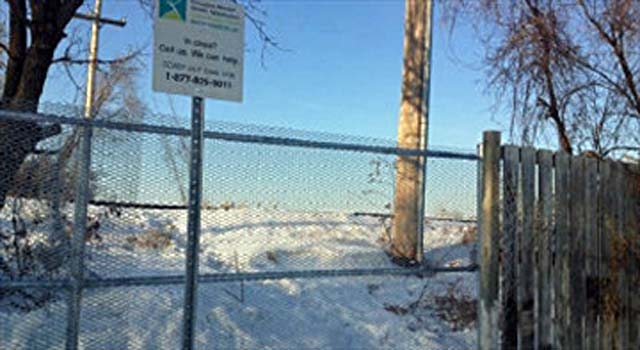|
New safety measures around railway tracks in Burlington include high-density fencing and signs meant to assist suicidal
people - Date unknown Denise Davy.
13 January 2014
Burlington on Track for Rail Safety
Burlington Ontario - Two people have been killed by trains in the last two weeks, a 19-year-old woman in Mississauga, and a 23-year-old
man in Oakville.
It's unlikely you heard about it, however, because pedestrian train fatalities don't get the same level of attention as when a cyclist is killed by a
car.
When you consider that 65 cyclists die on Canadian roads every year (on average), and compare that to the 113 people (on average) who are killed by trains, it
doesn't add up.
We also hear a lot about derailments, which makes sense given the often catastrophic impact they have on communities.
What most people don't know, however, is that far more pedestrians are killed by trains than in derailments (on average) annually.
In fact, trespassing fatalities and accidents, combined with crossing accidents, account for almost all railway fatalities and serious injuries in
Canada.
Most deaths occur at non-vehicle crossing areas.
Last spring, six people were killed by trains over a six-month period along a stretch of track from central Burlington to west Oakville.
I approached Burlington city council to request something be done.
The issue was personal for me as my son, Ryan, was killed by a train in the same area many years ago.
The key problem in Burlington is proximity and lack of proper fencing.
The tracks that run through parts of the city are a short walk from stores and restaurants and, at several spots, there was wide open access.
Well-worn footpaths show where people frequently cross the tracks.
Members of council weren't aware of the problem and voted unanimously to take immediate action.
Since then, the city has taken a giant step forward in implementing widespread changes.
Cindy Mercanti, who works at the city and spearheaded the rail safety review, was successful in bringing together representatives from GO, CN, CP, VIA Rail,
Transport Canada, the Transportation Safety Board, and also called on the Railway Safety Association and Operation Lifesaver for information.
All worked together for the first time to review short and long-term safety measures and agreed to meet on an annual basis to ensure the measures are
sustainable.
Much has been accomplished as a result.
High density fencing was erected at Woodview and Cumberland streets where the most people had been killed and existing fencing was upgraded in areas where it
had been damaged.
New signs were put up with the number for COAST Halton, a mobile mental health agency, which is an extremely important as it's estimated that around half of
pedestrian train deaths are suicides.
To explore the mental health issue further, Mercanti set up a subgroup made up of GO police, local police, COAST Halton, other mental health agencies, and
myself, because of my research into mental health.
This is a complex problem with no easy solutions but, at the very least, we are hoping to dispel the misconception that a person contemplating suicide will
ultimately find a way to end their life.
This was dispelled in a California study that followed several thwarted jumpers who had tried to take their lives on the Golden Gate Bridge and found that only
6 percent went on to commit suicide.
It's an important myth to challenge on this issue because I believe it is one of the reasons behind the complacency around pedestrian train
fatalities.
Burlington may well be the first municipality in the country to tackle the issue of pedestrian train deaths with such intensity and to have accomplished such
success.
The city has created a finely tuned process for making the tracks safer for pedestrians and it is sustainable.
Their work is being done at a time when rail safety is on the public radar, partly because of the derailment tragedy in Lake Megantic.
With the issue already in the spotlight, it's time to widen the lens to include pedestrian and trespasser train fatalities.
Barb Adams would like to see all municipalities adopt the same safety measures.
Her son Daine Humphreys, 17, was killed by a train in Burlington in 2004.
"Nothing will ever be able to turn back the hands of time but it makes my heart happy to know that city council is doing all it can to prevent it from
happening to others."
Denise Davy.
   |


